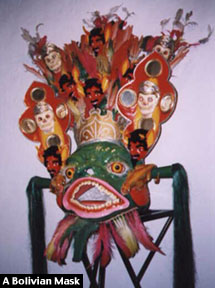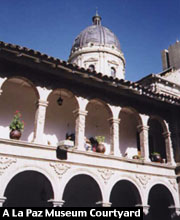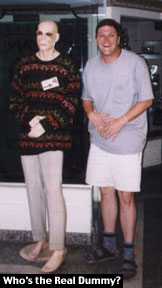
From July 8th to August 4th, 1998, truk and
Katherine traveled through various areas of central,
southern and coastal Peru, northwestern Bolivia, and northern Chile. The
following text is
taken from their diaries, with truk's writing in a normal font and Katherine's
in italics.
If you have an corrections or comments, please email
them to us [truk@truk.com].
 (LA PAZ; written in AREQUIPA). Coming into La Paz was a strange experience.
The city is down in the valley, between some high altiplano walls that curve
around in a bowl shape. Houses go up to the rim of the bowl and seem to
just fall off into it. The rich parts of town are in the bottom of the bowl
and stream like a river, slowly, out of it. The bus ride down into the bowl
was pretty cool. Once we got to the bus station, this guy we had happened
to be on every boat and bus the last week with (Chuck) offered to split
a cab to the big "gringo hotel." We accepted and paid the tab
when we got there. They were all booked up, so Kath and I stayed at the
Torino. We were forced to use an ATM for funds because one of the banks
did not seem to grasp the concept of two-party travelers checks and required
that Kath and I both sign the checks. Unfortunately, Kath didn't sign her
name on the checks the same as in the passport, and they thought we were
trying to rip them off. The next day, the 24th, we spent most of our time
going to museums and art galleries. We also got LANChile tickets to fly
to Arica on the 26th. Our plan to fly out of Santiago rather than Lima ran
into some big snags when we tried to change our tickets in La Paz. After
finally finding the United Airlines office in the city, we opened the door
to discover a little lady sitting a little desk with a United logo behind
it, shuffling some papers. In broken English, she told us that, while she
would like to help, "I, uh, really don't have contact with the reservations
people. You see, we really don't fly from here any more." Kath and
I left the building laughing and wondering what she did all day in that
lonely office and no contact with the outside world.
(LA PAZ; written in AREQUIPA). Coming into La Paz was a strange experience.
The city is down in the valley, between some high altiplano walls that curve
around in a bowl shape. Houses go up to the rim of the bowl and seem to
just fall off into it. The rich parts of town are in the bottom of the bowl
and stream like a river, slowly, out of it. The bus ride down into the bowl
was pretty cool. Once we got to the bus station, this guy we had happened
to be on every boat and bus the last week with (Chuck) offered to split
a cab to the big "gringo hotel." We accepted and paid the tab
when we got there. They were all booked up, so Kath and I stayed at the
Torino. We were forced to use an ATM for funds because one of the banks
did not seem to grasp the concept of two-party travelers checks and required
that Kath and I both sign the checks. Unfortunately, Kath didn't sign her
name on the checks the same as in the passport, and they thought we were
trying to rip them off. The next day, the 24th, we spent most of our time
going to museums and art galleries. We also got LANChile tickets to fly
to Arica on the 26th. Our plan to fly out of Santiago rather than Lima ran
into some big snags when we tried to change our tickets in La Paz. After
finally finding the United Airlines office in the city, we opened the door
to discover a little lady sitting a little desk with a United logo behind
it, shuffling some papers. In broken English, she told us that, while she
would like to help, "I, uh, really don't have contact with the reservations
people. You see, we really don't fly from here any more." Kath and
I left the building laughing and wondering what she did all day in that
lonely office and no contact with the outside world.
 The art museum housed primarily religious wares
- lots of paintings of saints, Mary and Jesus. There is a common practice
of painting fine gold, lacy type features on the peoples' robes in these
paintings. Very skilled and steady hands are required for that. The regional
natural history museum (actually called "Folklore and Ethnographic
Museum) was very poorly put together. Plus, it must have been school day
at the museums because there were middle-school children everywhere, scurrying
about with notebooks and pens, dotting down notes about the exhibits and
making out in the darker corners. The Tambo Museum was actually pretty interesting.
It had masks from festivals along with modern or contemporary art, silver
works, lots of sculpture, and a photo exhibit showing how La Paz has changed
over the past century. Those were very interesting. We were a little rushed
in this museum because Godzilla was playing at 7 pm and Stacy needed his
movie fix. So, we spent a few hours watching Hollywood tripe with Spanish-subtitles.
It wasn't a bad film but definitely not one I would have chosen to have
seen at home.
The art museum housed primarily religious wares
- lots of paintings of saints, Mary and Jesus. There is a common practice
of painting fine gold, lacy type features on the peoples' robes in these
paintings. Very skilled and steady hands are required for that. The regional
natural history museum (actually called "Folklore and Ethnographic
Museum) was very poorly put together. Plus, it must have been school day
at the museums because there were middle-school children everywhere, scurrying
about with notebooks and pens, dotting down notes about the exhibits and
making out in the darker corners. The Tambo Museum was actually pretty interesting.
It had masks from festivals along with modern or contemporary art, silver
works, lots of sculpture, and a photo exhibit showing how La Paz has changed
over the past century. Those were very interesting. We were a little rushed
in this museum because Godzilla was playing at 7 pm and Stacy needed his
movie fix. So, we spent a few hours watching Hollywood tripe with Spanish-subtitles.
It wasn't a bad film but definitely not one I would have chosen to have
seen at home.
Seeking a little R&R, we secured a reservation at a good hotel for the next night. With evening coming on, we did what we did best: walked around, trying to blend in and enjoy just being there. Before turning in, we did have a wonderful meal at El Lobo. Every recommended place, if you catch yourself in Central La Paz.
 The next day, we got up late, ate a leisurely breakfast, changed hotels
(where the cost increased three fold), tried to see some museums (but they
were closed because, well, it is Latin America and thing just randomly close),
and hiked down to the embassy section of town where a major bridge crosses
a minor canyon running through the city, and took a taxi back through town.
That night, we headed back down toward the bridge to find a good place to
eat but they were all too expensive. We settled on Mongos, a gringo hang-out
with monster burgers and ESPN2 (excuse me, I mean espn2). We talked
a while with the owner, a young British lady. She didn't look like she was
going anywhere soon; the place was buzzing with activity. And the drinks
weren't cheap.
The next day, we got up late, ate a leisurely breakfast, changed hotels
(where the cost increased three fold), tried to see some museums (but they
were closed because, well, it is Latin America and thing just randomly close),
and hiked down to the embassy section of town where a major bridge crosses
a minor canyon running through the city, and took a taxi back through town.
That night, we headed back down toward the bridge to find a good place to
eat but they were all too expensive. We settled on Mongos, a gringo hang-out
with monster burgers and ESPN2 (excuse me, I mean espn2). We talked
a while with the owner, a young British lady. She didn't look like she was
going anywhere soon; the place was buzzing with activity. And the drinks
weren't cheap.
On the 26th, we bought some things and checked out the witch's market near the hotel, where the stalls are filled with Cokes, toilet paper, potions, and dehydrated llama fetuses. We found a place open for breakfast, paid the hotel, and caught a cab to the airport (named the John F. Kennedy airport!). There, we had the pleasure of paying the Bolivian government $20 each as an "airport tax" just to leave the country. Domestic flights, most of which are further away than our destination, cost $2. As we queued to pass the first of three security checkpoints, I noticed that Americans actually designed and built the airport. Now, we get to help pay for it, too.
Lima
-> Huancayo -> Ayacucho
-> Cuzco -> Machu Picchu/Puno
-> Lake Titicaca ->
La Paz -> Arequipa -> Colca Canyon -> Nazca/Pisco/Lima